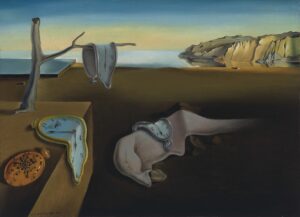“Relational Aesthetics” and “Surrealism Movement” are my main reading directions when looking for references in art theory. Next, I will introduce the above two concepts in detail and their influence on my exhibition planning.
“Relational Aesthetics” is a theory proposed by Nicolas Bourriaud in his Relational Aesthetics published in 1998, which subverts the traditional art paradigm. This theory argues that the core of art is to build temporary social relations, rather than create static aesthetic objects, and has had a profound impact on the field of contemporary art practice such as participatory art, social intervention art and interactive installation. In the theory of relational aesthetics, Boucheux believes that art is a “form within the social interstice”. Between the highly atomized individuals in modern society, art restores the nearly broken interpersonal relationship by creating temporary interactive space. Bucio’s concept of a “microutopia” (an idealized community created temporarily by artistic activity, such as a shared dinner or cooperative game, where participants can experience non-utilitarian communication), argues that the core value of art lies in whether it produces new social bonds, rather than in the materiality or visual impact of the work itself.
As a theory that subverts the traditional art paradigm, the theory of relational aesthetics focuses on the shift from “object” to “situation”, and pays attention to the timeliness and participation of artistic creation. According to Bucio, traditional art forms (such as painting and sculpture) are centered on aesthetic objects, and the audience plays the role of passive observer. In the theory of relational aesthetics, “context” is the core of artistic creation, and the audience becomes the co-producer of artistic works by participating in the process of art. Artist Rirkrit Tiravanija’s artistic activity untitled (free/still) is one example of this theory: the artist himself makes Thai curry soup in the gallery and invites the audience to share the meal. The significance of this artistic act is not the food itself, but the communication between the unfamiliar audience and the artist and the creation of temporary communities. This type of relational work relies on the real-time interaction of participants, and its existence cycle is bound with the timeliness of human social behaviors. A series of behaviors of the audience (such as communication, collaboration, and sharing) directly participate in the composition of the content of the work, while the artist himself provides the basic framework of the relational work.
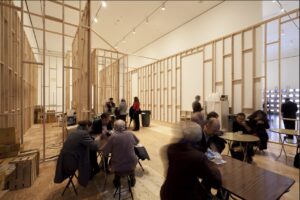
Rirkrit Tiravanija. untitled (free/still). 1992/1995/2007/2011-
There are many practice cases and application strategies of relational aesthetics theory in the local art field. A series by Felix Gonzalez-Torres, for example, features free candy. By stacking loose candies on the floor or in a corner, felix re-expresses the non-representativeness of minimalism in a subversive way. The candy in these works can be removed and replaced at will, so the size of the works is constantly shrinking or expanding, which challenges the inherent thinking of traditional art forms and playfully expands the continuity and everyday nature of minimalist materials.
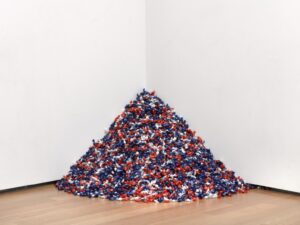
Felix Gonzalez-Torres. “Untitled” (USA Today). 1990
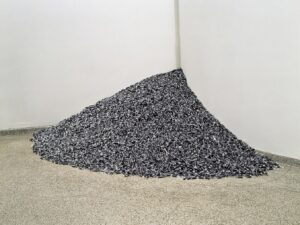
Felix Gonzalez-Torres, “Untitled” (Public Opinion), 1991.
In addition to felix, Sophie Calle’s 1979 work fifth sleeper is also one of the representative works of relational aesthetics theory. sophie invited strangers to sleep in her bed and recorded their behavior during this period, exploring the tension between trust and surveillance by observing the way strange individuals invade private space.
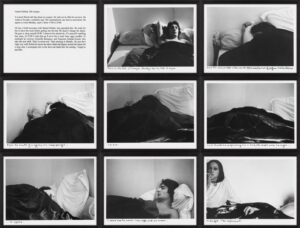
Gérard Maillet, fifth sleeper, 1979
Because of its subversion of the traditional art paradigm, the theory of relational aesthetics has been criticized and disputed. For example, Claire Bishop once criticized Buscio for ignoring the existence of conflict and power differences in his theory of relational aesthetics and romanticizing social interaction into a “consensus utopia”. On the other hand, relational art is often packaged as an “experience commodity” by the art market, and audience participation is reduced to the consumption of the commodity. This controversy is mainly found in the field of interactive installation art (such as TeamLab), which is criticized as “Instagram art”. In addition, the strong timeliness of relational art works is also its limitation: such works that rely on immediate interaction are difficult to be permanently collected by museums, and their meaning will collapse with the disappearance of the context. For example, if felix’s candy pile is not used by the audience, it will lose its metaphorical connotation.
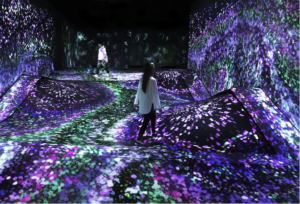
TeamLab Museum,Tokyo
References
Bourriaud, Nicolas. 2002. Relational Aesthetics. Translated by Simon Pleasance and Fronza Woods. Dijon: Les Presses du Réel.
Fraenkel Gallery. n.d. “Sophie Calle: #image-86649.” Accessed June 25, 2023. https://fraenkelgallery.com/artists/sophie-calle#image-86649-gallery_s-1.
Guggenheim Museum. n.d. “Wassily Kandinsky: Composition 8 (July 1923).” Accessed June 25, 2023. https://www.guggenheim.org/artwork/1512.
Museum of Modern Art (MoMA). n.d. “Mark Rothko: No. 3/No. 13 (1949).” Accessed June 25, 2023. https://www.moma.org/collection/works/147206.
Museum of Modern Art (MoMA). n.d. “Felix Gonzalez-Torres.” Artists. Accessed June 25, 2023. https://www.moma.org/artists/2233-felix-gonzalez-torres.
teamLab. n.d. teamLab Official Website. Accessed June 25, 2023. https://www.teamlab.art/.
